Complete Mitochondrial Genome and Phylogenetic Analysis of Tarsiger indicus (Aves: Passeriformes: Muscicapidae)
Abstract
1. Introduction
2. Materials and Methods
2.1. Materials
2.2. Mitogenome Sequencing, Assembly, and Annotation
2.3. Comparative Mitogenomic Analyses
2.4. Mitogenomic Phylogenetic Analyses
3. Results and Discussion
3.1. Structure and Organization of the T. indicus Mitogenome
3.2. Codon Usage
3.3. Nucleotide Composition, Diversity, and Evolution
3.4. Mitochondrial Phylogenomics
4. Conclusions
Supplementary Materials
Author Contributions
Funding
Institutional Review Board Statement
Informed Consent Statement
Data Availability Statement
Acknowledgments
Conflicts of Interest
References
- Gill, F.; Donsker, D.; Rasmussen, P. IOC World Bird List (v13.2). Available online: https://www.worldbirdnames.org/new/ioc-lists/master-list-2/ (accessed on 8 August 2023).
- BirdLife International. Tarsiger indicus. The IUCN Red List of Threatened Species 2016: E.T22709743A94221641. Available online: https://www.iucnredlist.org/species/22709743/94221641 (accessed on 12 August 2023).
- Zheng, G. A Checklist on the Classification and Distribution of the Birds of China, 3rd ed.; Science Press: Beijing, China, 2017; p. 492. [Google Scholar]
- Liu, S.; Yu, J.; Cui, J.; Zhou, Y. White-browed Bush Robin (Tarsiger indicus) found in Shennongjia, Hubei Province. Hubei For. Sci. Technol. 2017, 46, 45–75. [Google Scholar]
- Zeng, Z.; Gong, H. White-browed Bush Robin (Tarsiger indicus) found in the southern slope of Qinling Mountains in Shaanxi Province. Chin. J. Zool. 2018, 53, 39. [Google Scholar]
- Wei, C.; Sangster, G.; Olsson, U.; Rasmussen, P.C.; Svensson, L.; Yao, C.-T.; Carey, G.J.; Leader, P.J.; Zhang, R.; Chen, G.; et al. Cryptic species in a colorful genus: Integrative taxonomy of the bush robins (Aves, Muscicapidae, Tarsiger) suggests two overlooked species. Mol. Phylogenet. Evol. 2022, 175, 107580. [Google Scholar] [CrossRef] [PubMed]
- Zheng, G. A Checklist on the Classification and Distribution of the Birds of China, 4th ed.; Science Press: Beijing, China, 2023; p. 498. [Google Scholar]
- National Forestry and Grassland Administration. List of Terrestrial Wild Animals of Important Ecological, Scientific and Social Value in China. Available online: https://www.forestry.gov.cn/c/www/gsgg/509640.jhtml (accessed on 8 August 2023).
- Jiang, Z.; Jiang, J.; Wang, Y.; Zhang, E.; Zhang, Y.; Li, L.; Xie, F.; Cai, B.; Cao, L.; Zheng, G.; et al. Red List of China’s Vertebrates. Biodivers. Sci. 2016, 24, 500–551. [Google Scholar]
- Montaña-Lozano, P.; Moreno-Carmona, M.; Ochoa-Capera, M.; Medina, N.S.; Boore, J.L.; Prada, C.F. Comparative genomic analysis of vertebrate mitochondrial reveals a differential of rearrangements rate between taxonomic class. Sci. Rep. 2022, 12, 5479. [Google Scholar] [CrossRef] [PubMed]
- Lavrov, D.V.; Pett, W. Animal mitochondrial DNA as we do not know it: Mt-genome organization and evolution in nonbilaterian lineages. Genome Biol. Evol. 2016, 8, 2896–2913. [Google Scholar] [CrossRef] [PubMed]
- Winkelmann, I.; Campos, P.F.; Strugnell, J.; Cherel, Y.; Smith, P.J.; Kubodera, T.; Allcock, L.; Kampmann, M.-L.; Schroeder, H.; Guerra, A.; et al. Mitochondrial genome diversity and population structure of the giant squid Architeuthis: Genetics sheds new light on one of the most enigmatic marine species. Proc. R. Soc. B Biol. Sci. 2013, 280, 20130273. [Google Scholar] [CrossRef] [PubMed]
- Deng, M.-X.; Xiao, B.; Yuan, J.-X.; Hu, J.-M.; Kim, K.S.; Westbury, M.V.; Lai, X.-L.; Sheng, G.-L. Ancient mitogenomes suggest stable mitochondrial clades of the Siberian roe deer. Genes 2022, 13, 114. [Google Scholar] [CrossRef]
- Wu, L.; Tong, Y.; Ayivi, S.P.; Storey, K.B.; Zhang, J.-Y.; Yu, D.-N. The complete mitochondrial genomes of three Sphenomorphinae species (Squamata: Scincidae) and the selective pressure analysis on mitochondrial genomes of limbless Isopachys Gyldenstolpei. Animals 2022, 12, 2015. [Google Scholar] [CrossRef]
- Sangster, G.; Luksenburg, J.A. Sharp increase of problematic mitogenomes of birds: Causes, consequences, and remedies. Genome Biol. Evol. 2021, 13, evab210. [Google Scholar] [CrossRef]
- Li, M.; Chen, W.-T.; Zhang, Q.-L.; Liu, M.; Xing, C.-W.; Cao, Y.; Luo, F.-Z.; Yuan, M.-L. Mitochondrial phylogenomics provides insights into the phylogeny and evolution of spiders (Arthropoda: Araneae). Zool. Res. 2022, 43, 566–584. [Google Scholar] [CrossRef] [PubMed]
- Iacolina, L.; Buzan, E.; Safner, T.; Bašić, N.; Geric, U.; Tesija, T.; Lazar, P.; Arnal, M.C.; Chen, J.; Han, J.; et al. A mother’s story, mitogenome relationships in the genus Rupicapra. Animals 2021, 11, 1065. [Google Scholar] [CrossRef]
- Yu, J.; Liu, J.; Li, C.; Wu, W.; Feng, F.; Wang, Q.; Ying, X.; Qi, D.; Qi, G. Characterization of the complete mitochondrial genome of Otus lettia: Exploring the mitochondrial evolution and phylogeny of owls (Strigiformes). Mitochondrial DNA Part B 2021, 6, 3443–3451. [Google Scholar] [CrossRef] [PubMed]
- Catanese, G.; Morey, G.; Verger, F.; Grau, A.M. The Nursehound Scyliorhinus stellaris mitochondrial genome—Phylogeny, relationships among Scyliorhinidae and variability in waters of the Balearic Islands. Int. J. Mol. Sci. 2022, 23, 10355. [Google Scholar] [CrossRef] [PubMed]
- Liu, J.; Yu, J.; Zhou, M.; Yang, J. Complete mitochondrial genome of Japalura flaviceps: Deep insights into the phylogeny and gene rearrangements of Agamidae species. Int. J. Biol. Macromol. 2019, 125, 423–431. [Google Scholar] [CrossRef] [PubMed]
- Caparroz, R.; Rocha, A.V.; Cabanne, G.S.; Tubaro, P.; Aleixo, A.; Lemmon, E.M.; Lemmon, A.R. Mitogenomes of two neotropical bird species and the multiple independent origin of mitochondrial gene orders in Passeriformes. Mol. Biol. Rep. 2018, 45, 279–285. [Google Scholar] [CrossRef] [PubMed]
- He, K.; Chen, X.; Qiu, Y.-B.; Liu, Z.; Wang, W.-Z.; Woodman, N.; Maldonado, J.E.; Pan, X. Mitogenome and phylogenetic analyses support rapid diversification among species groups of small-eared shrews genus Cryptotis (Mammalia: Eulipotyphla: Soricidae). Zool. Res. 2021, 42, 739–745. [Google Scholar] [CrossRef] [PubMed]
- Yang, N.; Liu, W.; Yang, K. The complete mitochondrial genome of the snowy-browed flycatcher Ficedula hyperythra (Passeriformes, Muscicapidae). Mitochondrial DNA Part B 2021, 6, 2870–2871. [Google Scholar] [CrossRef]
- Li, F.-j.; Qiao, L.; Yang, Y.-j.; Yang, K.; Yang, N.; Yue, B.-s. The complete mitochondrial genome of Phoenicurus frontalis (Passeriformes: Muscicapidae). Mitochondrial DNA Part B 2020, 5, 2322–2323. [Google Scholar] [CrossRef]
- Du, C.; Liu, L.; Liu, Y.; Fu, Z.; Xu, Y. The complete mitochondrial genome of Daurian redstart Phoenicurus auroreus (Aves: Passeriformes: Muscicapidae). Mitochondrial DNA Part B 2020, 5, 2231–2232. [Google Scholar] [CrossRef]
- Zhang, N.; Zhao, Y.; Meng, D.; Zhou, X.; Liu, Z.; Teng, L. The complete mitochondrial genome of the Siberian Rubythroat (Calliope calliope) from Maorshan, China. Mitochondrial DNA Part B 2023, 8, 110–112. [Google Scholar] [CrossRef] [PubMed]
- Lu, C.-H.; Sun, C.-H.; Hou, S.-L.; Huang, Y.-L.; Lu, C.-H. The complete mitochondrial genome of dark-sided flycatcher Muscicapa sibirica (Passeriformes: Muscicapidae). Mitochondrial DNA Part B 2019, 4, 2675–2676. [Google Scholar] [CrossRef] [PubMed]
- Liu, B.; Sun, C.-H.; Wang, L.-B.; Xue, D.-D.; Xu, P.; Xie, S.-B.; Lu, C.-H. The complete mitochondrial genome of Grey-streaked Flycatcher Muscicapa griseisticta (Passeriformes: Muscicapidae). Mitochondrial DNA Part B 2019, 4, 1857–1858. [Google Scholar] [CrossRef]
- Min, X.; Lu, C.-H.; Chen, T.-Y.; Liu, B.; Lu, C.-H. The complete mitochondrial genome of Asian brown flycatcher Muscicapa latirostris (Passeriformes: Muscicapidae). Mitochondrial DNA Part B 2019, 4, 3880–3881. [Google Scholar] [CrossRef] [PubMed]
- Li, S.; Luo, A.; Li, G.; Li, W. Complete mitochondrial genome of the isabelline wheatear Oenanthe isabellina (Passeriformes, Muscicapidae). Mitochondrial DNA Part B 2016, 1, 355–356. [Google Scholar] [CrossRef] [PubMed]
- Feng, S.; Stiller, J.; Deng, Y.; Armstrong, J.; Fang, Q.; Reeve, A.H.; Xie, D.; Chen, G.; Guo, C.; Faircloth, B.C.; et al. Dense sampling of bird diversity increases power of comparative genomics. Nature 2020, 587, 252–257. [Google Scholar] [CrossRef] [PubMed]
- Peng, L.-F.; Yang, D.-C.; Lu, C.-H. Complete mitochondrial genome of oriental magpie-robin Copsychus saularis (Aves: Muscicapidae). Mitochondrial DNA Part B 2016, 1, 21–22. [Google Scholar] [CrossRef] [PubMed]
- Ekblom, R.; Smeds, L.; Ellegren, H. Patterns of sequencing coverage bias revealed by ultra-deep sequencing of vertebrate mitochondria. BMC Genom. 2014, 15, 467. [Google Scholar] [CrossRef]
- Zhang, H.; Bai, Y.; Shi, X.; Sun, L.; Wang, Z.; Wu, X. The complete mitochondrial genomes of Tarsiger cyanurus and Phoenicurus auroreus: A phylogenetic analysis of Passeriformes. Genes Genom. 2018, 40, 151–165. [Google Scholar] [CrossRef]
- Zhou, C.; Jin, J.; Chen, Y.; Hao, Y.; Zhang, X.; Meng, Y.; Yang, N.; Yue, B. Two new complete mitochondrial genomes (Paradoxornis gularis and Niltava davidi) and their phylogenetic and taxonomic implications. Mitochondrial DNA Part B 2019, 4, 820–821. [Google Scholar] [CrossRef]
- Zhang, H.; Cheng, Y.; Zhou, L.; Dong, Y. Complete mitochondrial genome of white-throated rock-thrush Monticola cinclorhynchus gularis (Passeriformes: Muscicapidae). Mitochondrial DNA Part B 2016, 1, 684–685. [Google Scholar] [CrossRef]
- Zhang, X.; Ma, X.; Ha, J.; Wei, Y.; Zhao, Y.; Wei, S.; Zhong, X.; Cai, Z. Characterization of a complete mitochondrial genome of Turdus ruficollis (Passeriformes: Turdidae). Mitochondrial DNA Part B 2021, 6, 1623–1624. [Google Scholar] [CrossRef] [PubMed]
- Zhang, H.; Dong, Y.; Sun, G.; Wang, Q.; Dong, Y.; Dou, H.; Wei, Q. The complete mitochondrial genome of Turdus obscurus (Passeriformes: Turdidae). Mitochondrial DNA Part B 2021, 6, 3076–3077. [Google Scholar] [CrossRef] [PubMed]
- Sun, C.-H.; Xu, P.; Lu, C.-H.; Han, Q.; Lin, Y.-F.; Gao, Z.-J.; Lu, C.-H. Complete mitochondrial genome of the Grey thrush Turdus cardis (Aves, Turdidae). Mitochondrial DNA Part B 2020, 5, 1824–1825. [Google Scholar] [CrossRef]
- Li, J.; Miao, K.; Wu, X.; Wang, Q.; Hu, C.; Li, P. The complete mitogenome of scaly thrush Zoothera aurea (Passeriformes, Turdidae). Mitochondrial DNA Part B 2020, 5, 2936–2937. [Google Scholar] [CrossRef] [PubMed]
- Sun, C.-H.; Liu, B.; Lu, C.-H. Complete mitochondrial genome of the Siberian thrush, Geokichla sibirica sibirica (Aves, Turdidae). Mitochondrial DNA Part B 2019, 4, 1150–1151. [Google Scholar] [CrossRef]
- Anmarkrud, J.A.; Lifjeld, J.T. Complete mitochondrial genomes of eleven extinct or possibly extinct bird species. Mol. Ecol. Resour. 2017, 17, 334–341. [Google Scholar] [CrossRef] [PubMed]
- Rollins, L.A.; Woolnough, A.P.; Fanson, B.G.; Cummins, M.L.; Crowley, T.M.; Wilton, A.N.; Sinclair, R.; Butler, A.; Sherwin, W.B. Selection on mitochondrial variants occurs between and within individuals in an expanding invasion. Mol. Biol. Evol. 2016, 33, 995–1007. [Google Scholar] [CrossRef]
- Wen, L.; Yang, X.; Liao, J.; Fu, Y.; Dai, B. The complete mitochondrial genome of the fulvous parrotbill Paradoxornis fulvifrons (Passeriformes: Muscicapidae). Mitochondrial DNA Part A 2017, 28, 143–144. [Google Scholar] [CrossRef]
- Zhang, H.; Li, Y.; Wu, X.; Xue, H.; Yan, P.; Wu, X.-B. The complete mitochondrial genome of Paradoxornis webbianus (Passeriformes, Muscicapidae). Mitochondrial DNA 2015, 26, 879–880. [Google Scholar] [CrossRef]
- Jiao, S.-Y.; Liu, Z.-X.; Yu, F.; Yao, J.-Y.; Li, Y.-M.; Yan, S.-Q. Complete mitochondrial genome of Pallas’s Leaf Warbler (Phylloscopus proregulus). Mitochondrial DNA Part B 2018, 3, 211–212. [Google Scholar] [CrossRef] [PubMed]
- Tu, H.; Gao, J.; Jing, J.; Zhou, C.; Yue, B.; Zhang, X. The complete mitochondrial genome of grey-headed canary-flycatcher (Culicicapa ceylonensis, Muscicapidae, Passeriformes). Mitochondrial DNA Part B 2019, 4, 1079–1080. [Google Scholar] [CrossRef]
- Luo, T.; Yan, S.-S.; Xiao, N.; Zhou, J.-J.; Wang, X.-L.; Chen, W.-C.; Deng, H.-Q.; Zhang, B.-W.; Zhou, J. Phylogenetic analysis of combined mitochondrial genome and 32 nuclear genes provides key insights into molecular systematics and historical biogeography of Asian warty newts of the genus Paramesotriton (Caudata: Salamandridae). Zool. Res. 2022, 43, 787–804. [Google Scholar] [CrossRef] [PubMed]
- Sangster, G.; Alström, P.; Forsmark, E.; Olsson, U. Multi-locus phylogenetic analysis of Old World chats and flycatchers reveals extensive paraphyly at family, subfamily and genus level (Aves: Muscicapidae). Mol. Phylogenetics Evol. 2010, 57, 380–392. [Google Scholar] [CrossRef] [PubMed]
- Zhao, X. A Photographic Guide to the Birds of China; The Commercial Press: Beijing, China, 2018; p. 980. [Google Scholar]
- Liu, J.; Yu, J.; Yu, X.; Bi, W.; Yang, H.; Xue, F.; Zhang, G.; Zhang, J.; Yi, D.; Ma, R.; et al. Complete mitogenomes of ticks Ixodes acutitarsus and Ixodes ovatus parasitizing giant panda: Deep insights into the comparative mitogenomic and phylogenetic relationship of Ixodidae species. Genes 2022, 13, 2049. [Google Scholar] [CrossRef] [PubMed]
- Donath, A.; Jühling, F.; Al-Arab, M.; Bernhart, S.H.; Reinhardt, F.; Stadler, P.F.; Middendorf, M.; Bernt, M. Improved annotation of protein-coding genes boundaries in metazoan mitochondrial genomes. Nucleic Acids Res. 2019, 47, 10543–10552. [Google Scholar] [CrossRef]
- Zhu, T.; Sato, Y.; Sado, T.; Miya, M.; Iwasaki, W. MitoFish, MitoAnnotator, and MiFish Pipeline: Updates in 10 Years. Mol. Biol. Evol. 2023, 40, msad035. [Google Scholar] [CrossRef] [PubMed]
- Canbäck, B.; Laslett, D. ARWEN: A program to detect tRNA genes in metazoan mitochondrial nucleotide sequences. Bioinformatics 2008, 24, 172–175. [Google Scholar]
- Zheng, S.; Poczai, P.; Hyvönen, J.; Tang, J.; Amiryousefi, A. Chloroplot: An online program for the versatile plotting of organelle genomes. Front. Genet. 2020, 11, 576124. [Google Scholar] [CrossRef]
- Katoh, K.; Standley, D.M. MAFFT multiple sequence alignment software version 7: Improvements in performance and usability. Mol. Biol. Evol. 2013, 30, 772–780. [Google Scholar] [CrossRef]
- Tamura, K.; Stecher, G.; Kumar, S. MEGA11: Molecular Evolutionary Genetics Analysis Version 11. Mol. Biol. Evol. 2021, 38, 3022–3027. [Google Scholar] [CrossRef] [PubMed]
- Rozas, J.; Ferrer-Mata, A.; Sánchez-DelBarrio, J.C.; Guirao-Rico, S.; Librado, P.; Ramos-Onsins, S.E.; Sánchez-Gracia, A. DnaSP 6: DNA sequence polymorphism analysis of large data sets. Mol. Biol. Evol. 2017, 34, 3299–3302. [Google Scholar] [CrossRef] [PubMed]
- Lyu, F.; Han, F.; Ge, C.; Mao, W.; Chen, L.; Hu, H.; Chen, G.; Lang, Q.; Fang, C. OmicStudio: A composable bioinformatics cloud platform with real-time feedback that can generate high-quality graphs for publication. iMeta 2023, 2, e85. [Google Scholar] [CrossRef]
- Jarvis, E.D.; Mirarab, S.; Aberer, A.J.; Li, B.; Houde, P.; Li, C.; Ho, S.Y.W.; Faircloth, B.C.; Nabholz, B.; Howard, J.T.; et al. Whole-genome analyses resolve early branches in the tree of life of modern birds. Science 2014, 346, 1320–1331. [Google Scholar] [CrossRef] [PubMed]
- Kimball, R.T.; Oliveros, C.H.; Wang, N.; White, N.D.; Barker, F.K.; Field, D.J.; Ksepka, D.T.; Chesser, R.T.; Moyle, R.G.; Braun, M.J.; et al. A phylogenomic supertree of birds. Diversity 2019, 11, 109. [Google Scholar] [CrossRef]
- Fuchs, J.; Pasquet, E.; Couloux, A.; Fjeldså, J.; Bowie, R.C.K. A new Indo-Malayan member of the Stenostiridae (Aves: Passeriformes) revealed by multilocus sequence data: Biogeographical implications for a morphologically diverse clade of flycatchers. Mol. Phylogenetics Evol. 2009, 53, 384–393. [Google Scholar] [CrossRef] [PubMed]
- Ranwez, V.; Douzery, E.J.P.; Cambon, C.; Chantret, N.; Delsuc, F. MACSE v2: Toolkit for the alignment of coding sequences accounting for frameshifts and stop codons. Mol. Biol. Evol. 2018, 35, 2582–2584. [Google Scholar] [CrossRef] [PubMed]
- Talavera, G.; Castresana, J. Improvement of phylogenies after removing divergent and ambiguously aligned blocks from protein sequence alignments. Syst. Biol. 2007, 56, 564–577. [Google Scholar] [CrossRef]
- Xiang, C.-Y.; Gao, F.; Jakovlić, I.; Lei, H.-P.; Hu, Y.; Zhang, H.; Zou, H.; Wang, G.-T.; Zhang, D. Using PhyloSuite for molecular phylogeny and tree-based analyses. iMeta 2023, 2, e87. [Google Scholar] [CrossRef]
- Kalyaanamoorthy, S.; Minh, B.Q.; Wong, T.K.F.; von Haeseler, A.; Jermiin, L.S. ModelFinder: Fast model selection for accurate phylogenetic estimates. Nat. Methods 2017, 14, 587–589. [Google Scholar] [CrossRef]
- Ronquist, F.; Teslenko, M.; van der Mark, P.; Ayres, D.L.; Darling, A.; Höhna, S.; Larget, B.; Liu, L.; Suchard, M.A.; Huelsenbeck, J.P. MrBayes 3.2: Efficient Bayesian phylogenetic inference and model choice across a large model space. Syst. Biol. 2012, 61, 539–542. [Google Scholar] [CrossRef] [PubMed]
- Minh, B.Q.; Schmidt, H.A.; Chernomor, O.; Schrempf, D.; Woodhams, M.D.; von Haeseler, A.; Lanfear, R. IQ-TREE 2: New models and efficient methods for phylogenetic inference in the genomic era. Mol. Biol. Evol. 2020, 37, 1530–1534. [Google Scholar] [CrossRef] [PubMed]
- Minh, B.Q.; Nguyen, M.A.T.; von Haeseler, A. Ultrafast approximation for phylogenetic bootstrap. Mol. Biol. Evol. 2013, 30, 1188–1195. [Google Scholar] [CrossRef] [PubMed]
- Urantówka, A.D.; Kroczak, A.; Mackiewicz, P. New view on the organization and evolution of Palaeognathae mitogenomes poses the question on the ancestral gene rearrangement in Aves. BMC Genom. 2020, 21, 874. [Google Scholar] [CrossRef] [PubMed]
- Ding, H.; Bi, D.; Han, S.; Yi, R.; Zhang, S.; Ye, Y.; Gao, J.; Yang, J.; Kan, X. Mitogenomic codon usage patterns of superfamily Certhioidea (Aves, Passeriformes): Insights into asymmetrical bias and phylogenetic implications. Animals 2023, 13, 96. [Google Scholar] [CrossRef]
- Yuan, Q.; Guo, Q.; Cao, J.; Luo, X.; Duan, Y. Description of the three complete mitochondrial genomes of Sitta (S. himalayensis, S. nagaensis, and S. yunnanensis) and phylogenetic relationship (Aves: Sittidae). Genes 2023, 14, 589. [Google Scholar] [CrossRef]
- Adawaren, E.O.; Du Plessis, M.; Suleman, E.; Kindler, D.; Oosthuizen, A.O.; Mukandiwa, L.; Naidoo, V. The complete mitochondrial genome of Gyps coprotheres (Aves, Accipitridae, Accipitriformes): Phylogenetic analysis of mitogenome among raptors. PeerJ 2020, 8, e10034. [Google Scholar] [CrossRef]
- Jiang, L.; Peng, L.; Tang, M.; You, Z.; Zhang, M.; West, A.; Ruan, Q.; Chen, W.; Merilä, J. Complete mitochondrial genome sequence of the Himalayan Griffon, Gyps himalayensis (Accipitriformes: Accipitridae): Sequence, structure, and phylogenetic analyses. Ecol. Evol. 2019, 9, 8813–8828. [Google Scholar] [CrossRef]
- Li, X.; Huang, Y.; Lei, F. Comparative mitochondrial genomics and phylogenetic relationships of the Crossoptilon species (Phasianidae, Galliformes). BMC Genom. 2015, 16, 42. [Google Scholar] [CrossRef]
- Liu, H.-Y.; Sun, C.-H.; Zhu, Y.; Zhang, Q.-Z. Complete mitogenomic and phylogenetic characteristics of the speckled wood-pigeon (Columba hodgsonii). Mol. Biol. Rep. 2020, 47, 3567–3576. [Google Scholar] [CrossRef]
- Ojala, D.; Montoya, J.; Attardi, G. tRNA punctuation model of RNA processing in human mitochondria. Nature 1981, 290, 470–474. [Google Scholar] [CrossRef] [PubMed]
- Sun, C.-H.; Liu, H.-Y.; Min, X.; Lu, C.-H. Mitogenome of the little owl Athene noctua and phylogenetic analysis of Strigidae. Int. J. Biol. Macromol. 2020, 151, 924–931. [Google Scholar] [CrossRef] [PubMed]
- Bi, D.; Ding, H.; Wang, Q.; Jiang, L.; Lu, W.; Wu, X.; Zhu, R.; Zeng, J.; Zhou, S.; Yang, X.; et al. Two new mitogenomes of Picidae (Aves, Piciformes): Sequence, structure and phylogenetic analyses. Int. J. Biol. Macromol. 2019, 133, 683–692. [Google Scholar] [CrossRef] [PubMed]
- Wang, Z.; Zheng, Y.; Zhao, X.; Xu, X.; Xu, Z.; Cui, C. Molecular phylogeny and evolution of the Tuerkayana (Decapoda: Brachyura: Gecarcinidae) genus based on whole mitochondrial genome sequences. Biology 2023, 12, 974. [Google Scholar] [CrossRef] [PubMed]
- Liu, G.; Zhou, L.; Li, B.; Zhang, L. The complete mitochondrial genome of Aix galericulata and Tadorna ferruginea: Bearings on their phylogenetic position in the Anseriformes. PLoS ONE 2014, 9, e109701. [Google Scholar] [CrossRef] [PubMed][Green Version]
- Jia, C.; Zhang, X.; Xu, S.; Yang, T.; Yanagimoto, T.; Gao, T. Comparative analysis of the complete mitochondrial genomes of three rockfishes (Scorpaeniformes, Sebastiscus) and insights into the phylogenetic relationships of Sebastidae. Biosci. Rep. 2020, 40, BSR20203379. [Google Scholar] [CrossRef] [PubMed]
- Hong, Y.-H.; Huang, H.-M.; Wu, L.; Storey, K.B.; Zhang, J.-Y.; Zhang, Y.-P.; Yu, D.-N. Characterization of two mitogenomes of Hyla sanchiangensis (Anura: Hylidae), with phylogenetic relationships and selection pressure analyses of Hylidae. Animals 2023, 13, 1593. [Google Scholar] [CrossRef] [PubMed]
- Ramos, B.; González-Acuña, D.; Loyola, D.E.; Johnson, W.E.; Parker, P.G.; Massaro, M.; Dantas, G.P.M.; Miranda, M.D.; Vianna, J.A. Landscape genomics: Natural selection drives the evolution of mitogenome in penguins. BMC Genom. 2018, 19, 53. [Google Scholar] [CrossRef]
- Chen, W.; Qian, W.; Miao, K.; Qian, R.; Yuan, S.; Liu, W.; Dai, J.; Hu, C.; Chang, Q. Comparative mitogenomics of true frogs (Ranidae, Anura), and its implications for the phylogeny and evolutionary history of Rana. Animals 2022, 12, 1250. [Google Scholar] [CrossRef]
- Zheng, G. A Checklist on the Classification and Distribution of the Birds of the World; Science Press: Beijing, China, 2002; p. 400. [Google Scholar]
- Cai, T.; Cibois, A.; Alström, P.; Moyle, R.G.; Kennedy, J.D.; Shao, S.; Zhang, R.; Irestedt, M.; Ericson, P.G.P.; Gelang, M.; et al. Near-complete phylogeny and taxonomic revision of the world’s babblers (Aves: Passeriformes). Mol. Phylogenet. Evol. 2019, 130, 346–356. [Google Scholar] [CrossRef]
- Zheng, G. A Checklist on the Classification and Distribution of the Birds of China, 1st ed.; Science Press: Beijing, China, 2005; p. 444. [Google Scholar]
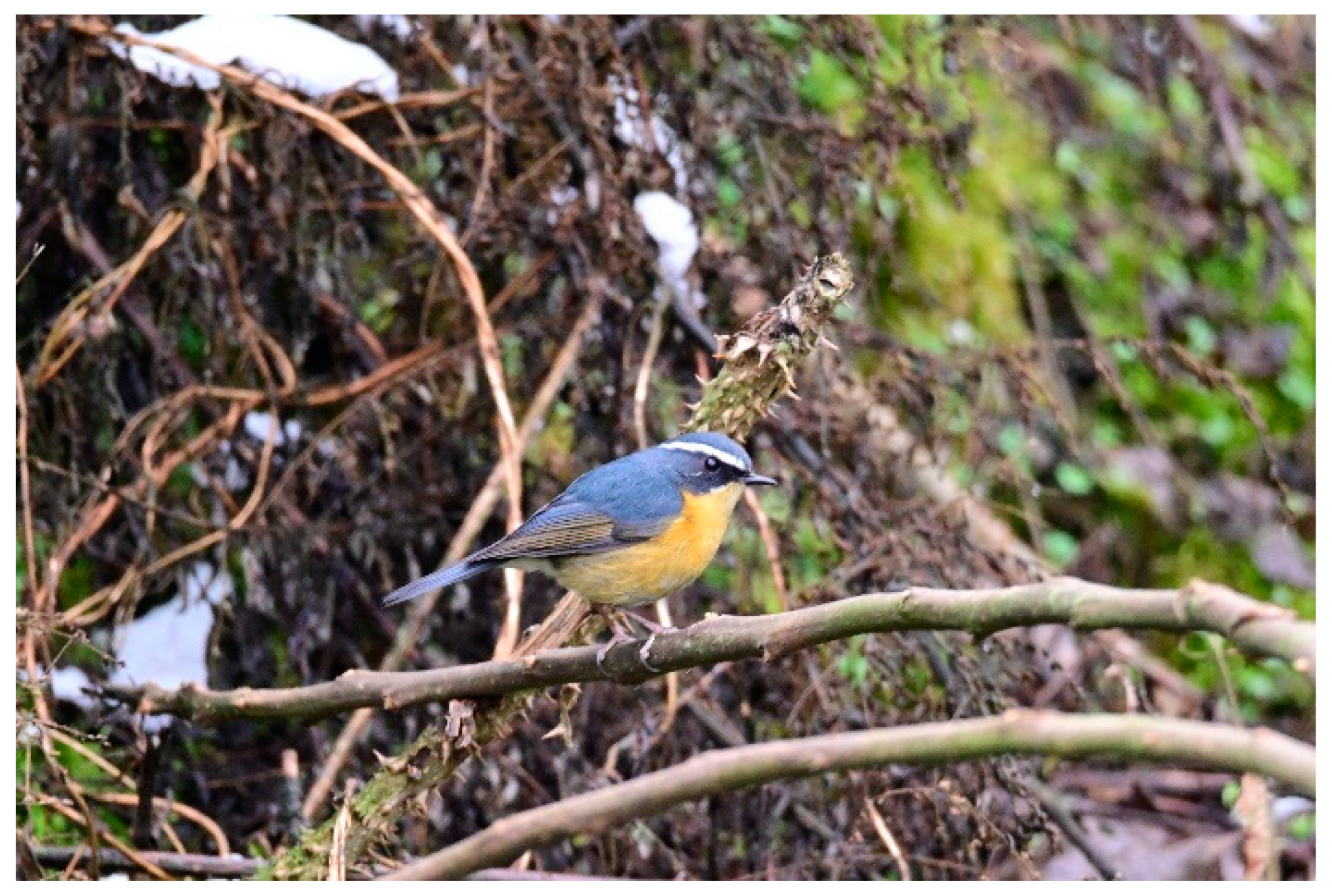
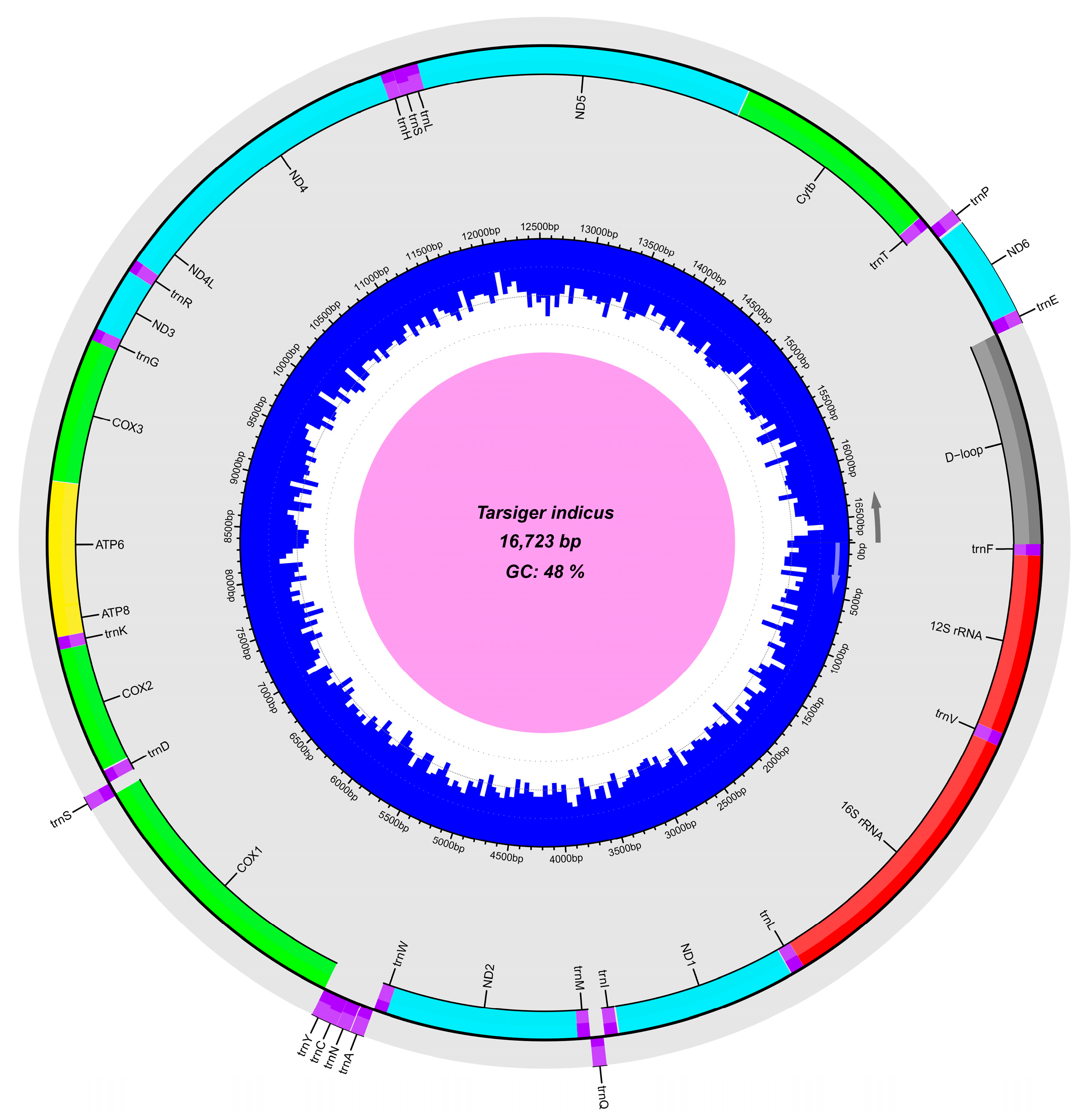
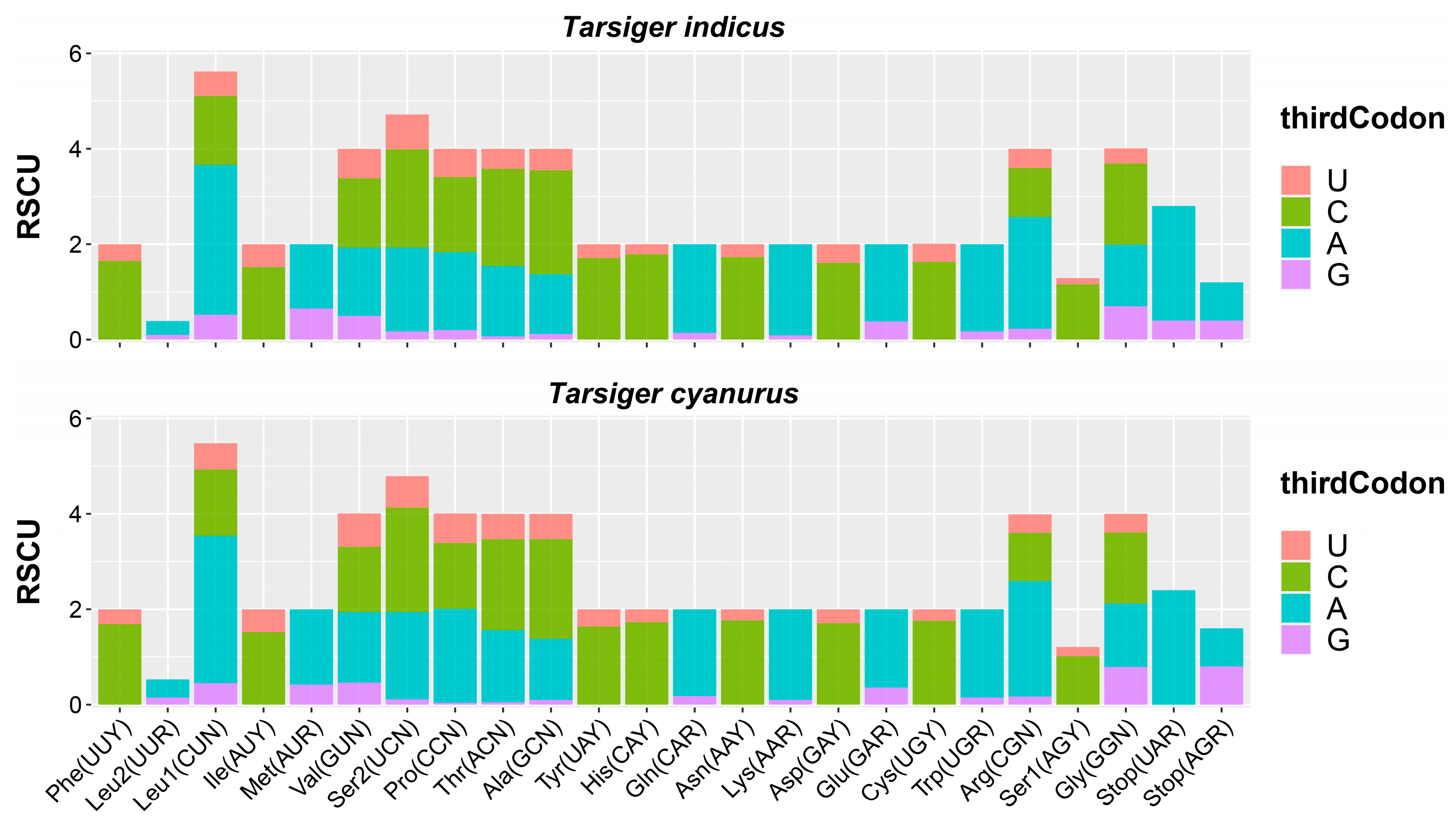
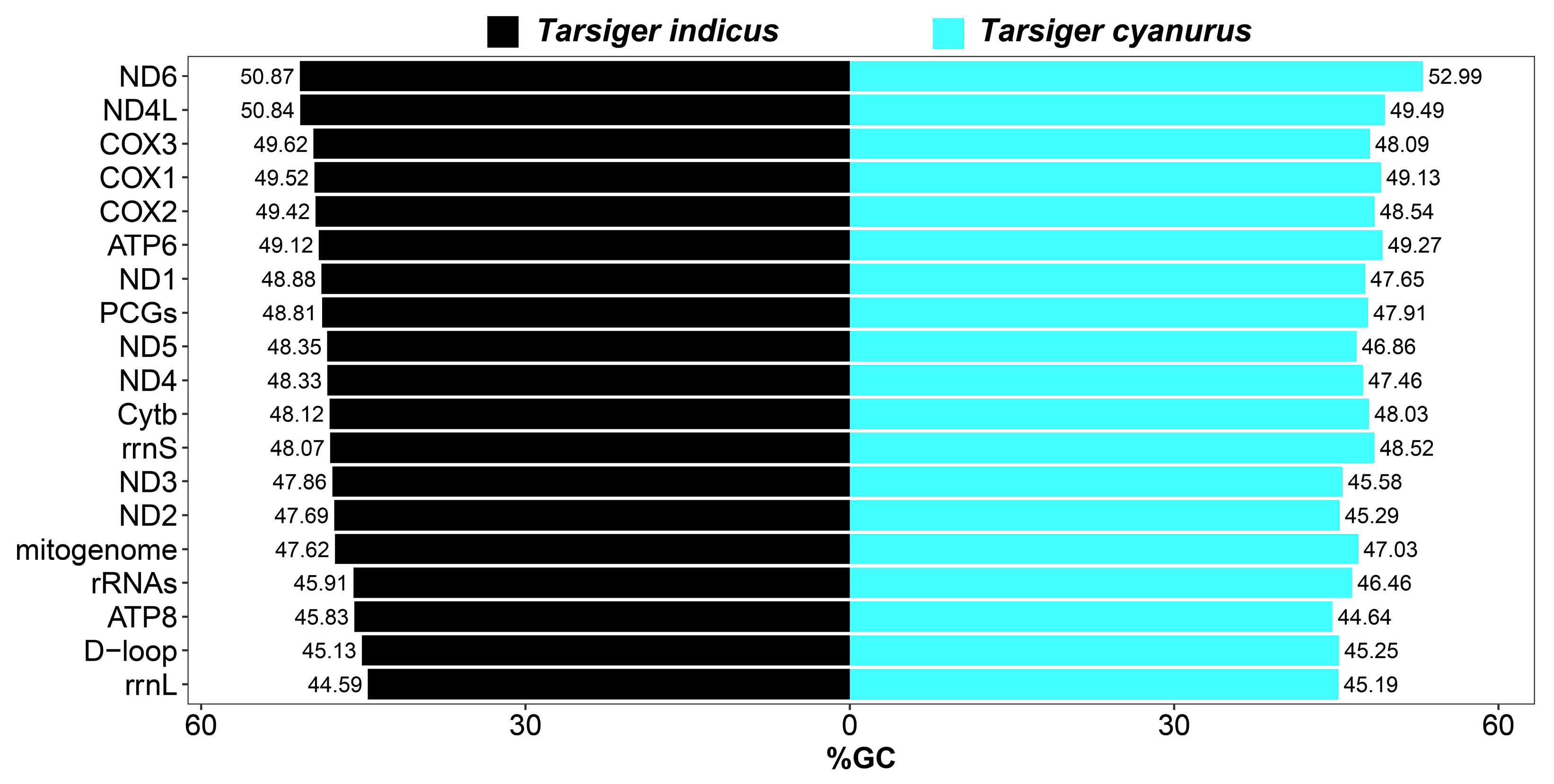
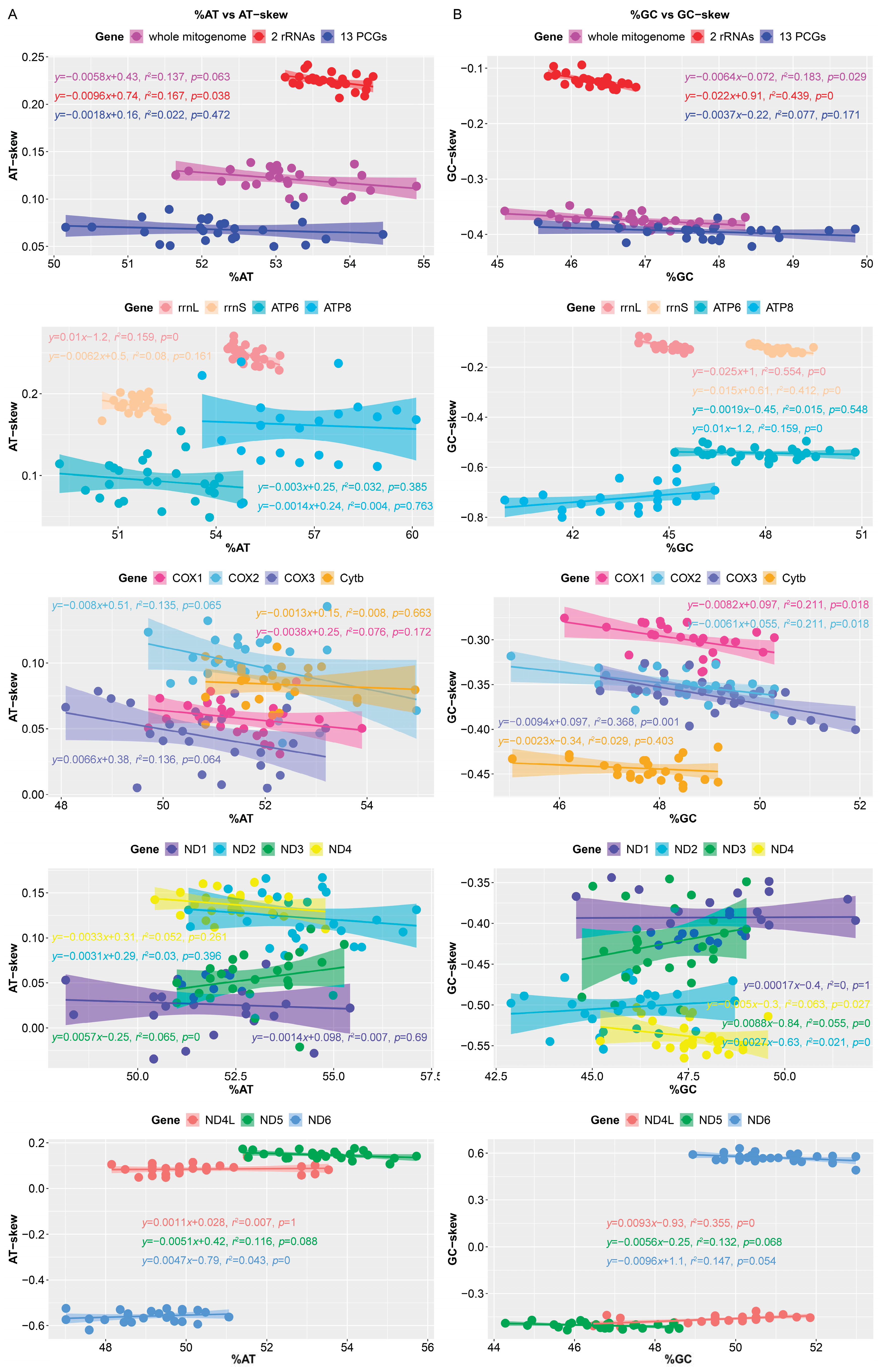
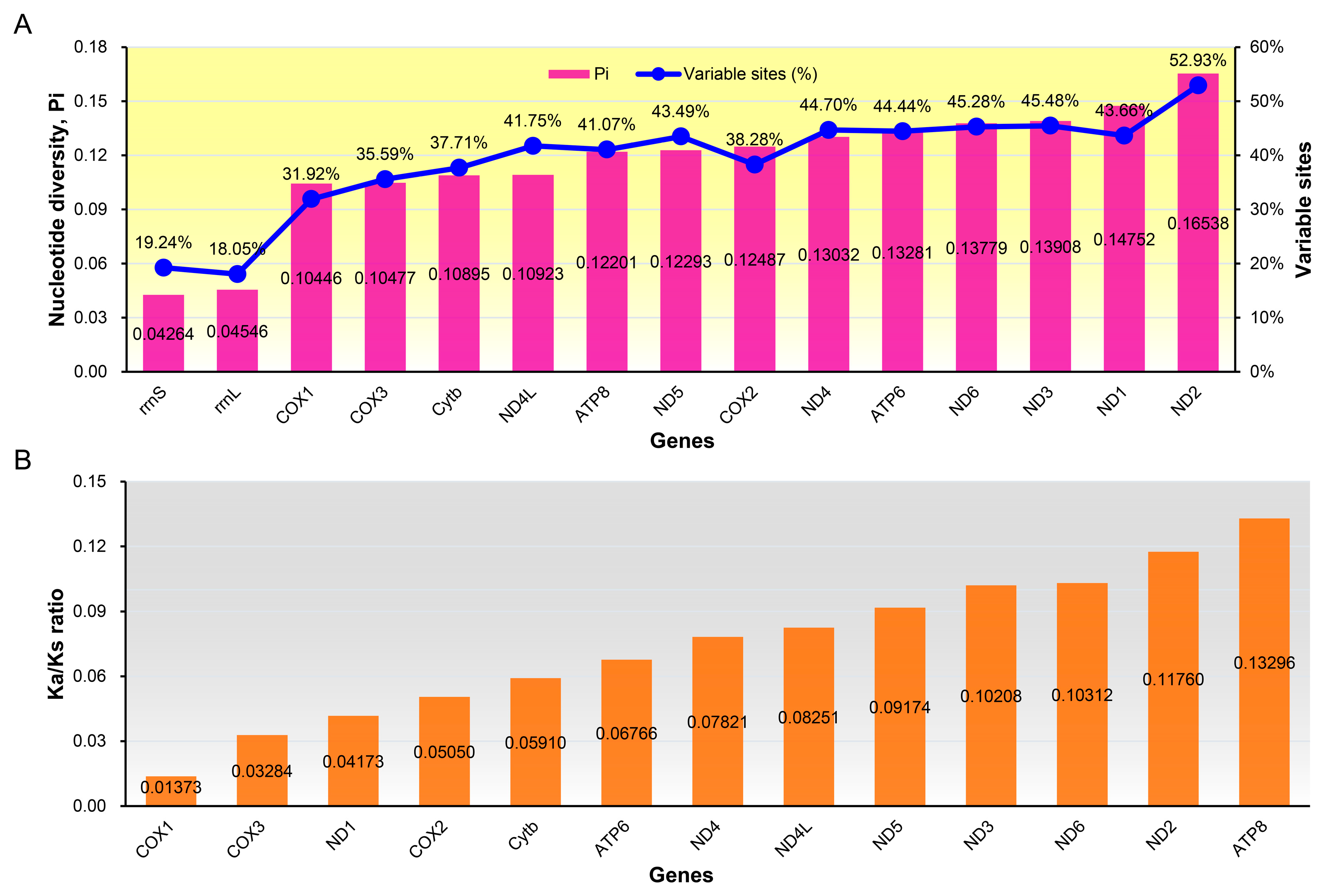
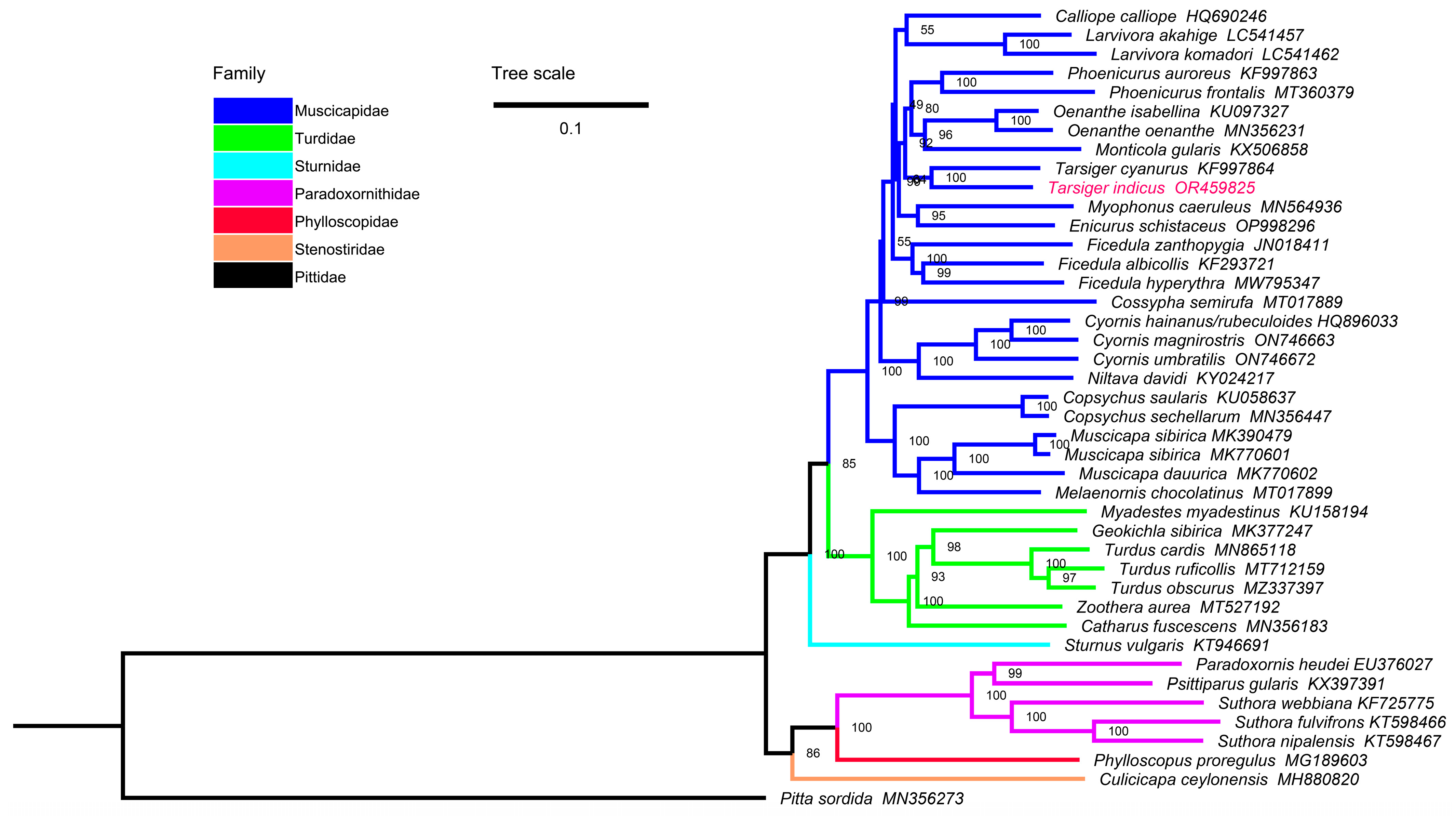
| Family | Species | GenBank No. | Mitogenome Size (bp) | References | |
|---|---|---|---|---|---|
| Muscicapidae | Oenanthe isabellina | KU097327 | NC_040290 | 16,812 | [30] |
| Oenanthe oenanthe | MN356231 | NC_051036 | 16,826 | [31] | |
| Copsychus saularis | KU058637 | NC_030603 | 16,827 | [32] | |
| Copsychus sechellarum | MN356447 | 16,839 | [31] | ||
| Muscicapa sibirica | MK770601 | NC_045374 | 17,879 | [27] | |
| Muscicapa sibirica | MK390479 | NC_045181 | 17,897 | [15,28] | |
| Muscicapa dauurica | MK770602 | NC_045375 | 18,026 | [29] | |
| Ficedula hyperythra | MW795347 | NC_058320 | 16,819 | [23] | |
| Ficedula albicollis | KF293721 | NC_021621 | 16,787 | [33] | |
| Ficedula zanthopygia | JN018411 | NC_015802 | 16,794 | Unpublished | |
| Phoenicurus auroreus | KF997863 | NC_026066 | 16,772 | [34] | |
| Phoenicurus frontalis | MT360379 | NC_053917 | 16,776 | [24] | |
| Calliope calliope | HQ690246 | NC_015074 | 16,841 | Unpublished | |
| Larvivora komadori | LC541462 | 16,812 | Unpublished | ||
| Larvivora akahige | LC541457 | 16,824 | Unpublished | ||
| Myophonus caeruleus | MN564936 | 16,815 | Unpublished | ||
| Enicurus schistaceus | OP998296 | NC_072120 | 17,112 | Unpublished | |
| Cyornis umbratilis | ON746672 | NC_068694 | 16,805 | Unpublished | |
| Cyornis magnirostris | ON746663 | NC_068687 | 16,816 | Unpublished | |
| Cyornis hainanus/rubeculoides | HQ896033 | NC_015232 | 16,802 | [15] | |
| Niltava davidi | KY024217 | NC_039538 | 16,770 | [35] | |
| Melaenornis chocolatinus | MT017899 | NC_052841 | 16,582 | Unpublished | |
| Cossypha semirufa | MT017889 | NC_052839 | 16,564 | Unpublished | |
| Tarsiger indicus | OR459825 | This study | |||
| Tarsiger cyanurus | KF997864 | NC_026067 | 16,803 | [34] | |
| Monticola gularis | KX506858 | NC_033536 | 16,801 | [36] | |
| Turdidae | Turdus ruficollis | MT712159 | NC_057250 | 16,737 | [37] |
| Turdus obscurus | MZ337397 | 16,739 | [38] | ||
| Turdus cardis | MN865118 | NC_046948 | 16,761 | [39] | |
| Zoothera aurea | MT527192 | NC_054298 | 16,712 | [40] | |
| Geokichla sibirica | MK377247 | 16,766 | [41] | ||
| Myadestes myadestinus | KU158194 | NC_031352 | 16,641 | [42] | |
| Catharus fuscescens | MN356183 | NC_051013 | 16,766 | [31] | |
| Sturnidae | Sturnus vulgaris | KT946691 | NC_029360 | 16,793 | [43] |
| Paradoxornithidae | Suthora fulvifrons | KT598466 | NC_028436 | 17,059 | [44] |
| Suthora nipalensis | KT598467 | NC_028437 | 16,996 | Unpublished | |
| Suthora webbiana | KF725775 | NC_024539 | 16,960 | [45] | |
| Paradoxornis heudei | EU376027 | 16,928 | Unpublished | ||
| Psittiparus gularis | KX397391 | NC_039536 | 17,109 | [35] | |
| Phylloscopidae | Phylloscopus proregulus | MG189603 | NC_037189 | 16,880 | [46] |
| Stenostiridae | Culicicapa ceylonensis | MH880820 | NC_042191 | 16,851 | [47] |
| Pittidae | Pitta sordida | MN356273 | NC_051463 | 17,733 | [31] |
| Gene | Location | Gene Length (bp) | Start/Stop Codon | |||
|---|---|---|---|---|---|---|
| T. indicus OR459825 | T. cyanurus KF997864 | T. indicus OR459825 | T. cyanurus KF997864 | T. indicus OR459825 | T. cyanurus KF997864 | |
| trnF (gaa) | 1–68: + | 1–68: + | 68 | 68 | ||
| rrnS | 69–1050: + | 69–1051: + | 982 | 983 | ||
| trnV (uac) | 1051–1120: + | 1052–1121: + | 70 | 70 | ||
| rrnL | 1121–2719: + | 1122–2723: + | 1599 | 1602 | ||
| trnL2 (uaa) | 2720–2794: + | 2724–2798: + | 75 | 75 | ||
| ND1 | 2800–3777: + | 2804–3781: + | 978 | 978 | ATG/AGA | ATG/AGA |
| trnI (gau) | 3787–3858: + | 3794–3865: + | 72 | 72 | ||
| trnQ (uug) | 3866–3936: − | 3873–3943: − | 71 | 71 | ||
| trnM (cau) | 3936–4004: + | 3943–4011: + | 69 | 69 | ||
| ND2 | 4005–5044: + | 4012–5051: + | 1040 | 1040 | GTG/TA | GTG/TA |
| trnW (uca) | 5045–5115: + | 5052–5122: + | 71 | 71 | ||
| trnA (ugc) | 5117–5185: − | 5124–5192: − | 69 | 69 | ||
| trnN (guu) | 5190–5262: − | 5197–5269: − | 73 | 73 | ||
| trnC (gca) | 5263–5329: − | 5270–5336: − | 67 | 67 | ||
| trnY (gua) | 5329–5399: − | 5336–5406: − | 71 | 71 | ||
| COX1 | 5401–6951: + | 5408–6958: + | 1551 | 1551 | GTG/AGG | GTG/AGG |
| trnS2 (uga) | 6943–7017: − | 6950–7024: − | 75 | 75 | ||
| trnD (guc) | 7021–7089: + | 7028–7096: + | 69 | 69 | ||
| COX2 | 7098–7781: + | 7104–7787: + | 684 | 684 | ATG/TAA | ATG/TAA |
| trnK (uuu) | 7783–7850: + | 7789–7856: + | 68 | 68 | ||
| ATP8 | 7852–8019: + | 7858–8025: + | 168 | 168 | ATG/TAA | ATG/TAA |
| ATP6 | 8010–8693: + | 8016–8699: + | 684 | 684 | ATG/TAA | ATG/TAA |
| COX3 | 8699–9482: + | 8705–9488: + | 784 | 784 | ATG/T | ATG/T |
| trnG (ucc) | 9483–9551: + | 9489–9557: + | 69 | 69 | ||
| ND3 | 9552–9902: + | 9558–9908: + | 351 | 351 | ATG/TAA | ATG/TAA |
| trnR (ucg) | 9904–9973: + | 9910–9979: + | 70 | 70 | ||
| ND4L | 9975–10,271: + | 9981–10,277: + | 297 | 297 | ATG/TAA | ATG/TAA |
| ND4 | 10,265–11,642: + | 10,271–11,648: + | 1378 | 1378 | ATG/T | ATG/T |
| trnH (gug) | 11,643–11,713: + | 11,649–11,719: + | 71 | 71 | ||
| trnS1 (gcu) | 11,714–11,780: + | 11,722–11,786: + | 67 | 65 | ||
| trnL1 (uag) | 11,780–11,850: + | 11,786–11,856: + | 71 | 71 | ||
| ND5 | 11,851–13,668: + | 11,857–13,674: + | 1818 | 1818 | ATG/AGA | ATG/AGA |
| Cytb | 13,677–14,819: + | 13,683–14,825: + | 1143 | 1143 | ATG/TAA | ATG/TAA |
| trnT (ugu) | 14,823–14,891: + | 14,829–14,897: + | 69 | 69 | ||
| trnP (ugg) | 14,899–14,968: − | 14,904–14,973: − | 70 | 70 | ||
| ND6 | 14,982–15,500: − | 14,990–15,508: − | 519 | 519 | ATG/TAG | ATG/AGG |
| trnE (uuc) | 15,502–15,573: − | 15,510–15,581: − | 72 | 72 | ||
| D-loop | 15,574–16,723: + | 15,582–16,803: + | 1150 | 1222 | ||
Disclaimer/Publisher’s Note: The statements, opinions and data contained in all publications are solely those of the individual author(s) and contributor(s) and not of MDPI and/or the editor(s). MDPI and/or the editor(s) disclaim responsibility for any injury to people or property resulting from any ideas, methods, instructions or products referred to in the content. |
© 2024 by the authors. Licensee MDPI, Basel, Switzerland. This article is an open access article distributed under the terms and conditions of the Creative Commons Attribution (CC BY) license (https://creativecommons.org/licenses/by/4.0/).
Share and Cite
Lan, G.; Yu, J.; Liu, J.; Zhang, Y.; Ma, R.; Zhou, Y.; Zhu, B.; Wei, W.; Liu, J.; Qi, G. Complete Mitochondrial Genome and Phylogenetic Analysis of Tarsiger indicus (Aves: Passeriformes: Muscicapidae). Genes 2024, 15, 90. https://doi.org/10.3390/genes15010090
Lan G, Yu J, Liu J, Zhang Y, Ma R, Zhou Y, Zhu B, Wei W, Liu J, Qi G. Complete Mitochondrial Genome and Phylogenetic Analysis of Tarsiger indicus (Aves: Passeriformes: Muscicapidae). Genes. 2024; 15(1):90. https://doi.org/10.3390/genes15010090
Chicago/Turabian StyleLan, Guanwei, Jiaojiao Yu, Juan Liu, Yue Zhang, Rui Ma, Yanshan Zhou, Biqing Zhu, Wei Wei, Jiabin Liu, and Guilan Qi. 2024. "Complete Mitochondrial Genome and Phylogenetic Analysis of Tarsiger indicus (Aves: Passeriformes: Muscicapidae)" Genes 15, no. 1: 90. https://doi.org/10.3390/genes15010090
APA StyleLan, G., Yu, J., Liu, J., Zhang, Y., Ma, R., Zhou, Y., Zhu, B., Wei, W., Liu, J., & Qi, G. (2024). Complete Mitochondrial Genome and Phylogenetic Analysis of Tarsiger indicus (Aves: Passeriformes: Muscicapidae). Genes, 15(1), 90. https://doi.org/10.3390/genes15010090







